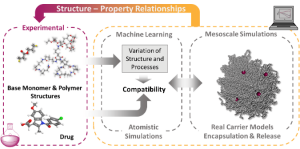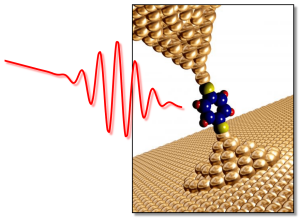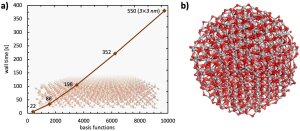Current Projects
Materials Ontology and Data-driven Accelerated Materials Development
The central idea of GlasDigital: a fully automated intelligent expert system for high-throughput glass design, consisting of a high-throughput glass synthesis robot controlled by an ontology-based digital infrastructure.
Graphic: Computational Materials Science GroupDigitization in the field of Materials Science and Engineering is the key element for a better understanding of material properties and behavior, for more targeted optimizations and for more efficient development and production processes. Based on our experience with computational glass development, we are involved in the digitization of the glass material class within the project GlasDigitalExternal link, funded by the German Federal Ministry of Education and Research (BMBF), in collaboration with the Innovation Platform MaterialDigitalExternal link, a German initiative for the digitization of materials that brings together partners from science and industry.
Glass materials are key components of modern and future cutting-edge technologies due to the broadly adjustable property spectrum, the cost-effective production of variable geometries as well as the high recycling rate and thus sustainability. However, data-driven methods for glass development and process optimization are not yet well established. Therefore, GlasDigital aims at the establishment of an ontology-based digital infrastructure and the development of embedded fully automated intelligent expert system for high-throughput glass design.
Within the GlasDigital project, we are developing an ontology and associated workflow environment for the glass material class, including standards for data consistency and metadata structure of glass design datasets. Based on the developed ontology, a central database has been created, including strategies for its long-term maintenance. In addition, we are developing machine learning-based software tools for the prediction of glass properties and suitable process parameters. In combination with the robotic synthesis methods, the development of novel - e.g. mechanically stronger - glasses will be significantly accelerated and made more cost-effective.
In Silico Design of Polymers for Targeted Drug Delivery
Engineering of new new biodegradable polymeric nanocarriers in a combined experimental and in silico approach. The synthetic part is guided by structure-property relationships derived from machine learning models combined with atomistic and mesoscale simulations.
Graphic: Computational Materials Science GroupCombating inflammatory disease such as infections is of great importance to mankind and requires novel strategies for effective and safe pharmacotherapy. Current approaches to medication of inflammatory diseases suffer from limited biocompatibility and organ specificity of available drugs and are associated with serious side effects.
The Collaborative Research Center 1278 PolyTarget develops innovative approaches to solve these treatment hurdles using cell type-specific polymeric nanoparticles that selectively intervene at different stages of inflammatory processes. Newly developed drugs encapsulated in tissue-specific nanoparticles enable resolution of local and systemic inflammatory responses and protect distant organs. Using these strategies, PolyTarget addresses a broad spectrum of inflammatory diseases that lead to organ failure, i.e. sepsis, among others.
Our project within PolyTarget aims at engineering new biodegradable polymeric nanocarriers in a combined experimental and in silico approach to maximize the drug encapsulation efficiency of nanoparticles. For this purpose, syntheses of polymers are guided by machine learning models in combination with atomistic and mesoscale simulations. The central component of the project is a semantic knowledge base that organizes process-dependent information about polymeric nanocarriers and drugs and serves as a source of information for deriving machine learning models.
Modeling the Nonlinear Optical Response of Functionalized Surfaces
Schematic representation of a hybrid system consisting of a molecule bonded to a metallic surface structure.
Graphic: Computational Materials Science GroupMost interaction between light and matter relevant to our daily life scales linearly with the incident intensity. However, nonlinear optical processes already begin to occur for light at moderate intensities, becoming more pronounced at higher field strengths. As a consequence, properties of light are modified, manifesting themselves in amplitude, phase, polarization or frequency changes. General examples of nonlinear optical processes are lasing and the generation of coherent light. Important specific applications are frequency conversion, supercontinuum and atto-second pulse generation. The investigation of these processes is the focus of Collaborative Research Center 1375 Nonlinear Optics down to Atomic scales (NOA), to which our group makes important contributions.
The main focus of Our research within NOAExternal link is the modeling and simulations of the optical behavior of hybrid systems consisting of molecules adsorbed or attached to metallic and semiconductor surfaces, semiconductor nanowires, nanoparticles, and 2D materials. This central goal necessitates the development and application of accurate and computationally efficient simulation methods for the description of such materials. The systems of interest are mainly individual molecules attached to semiconductor and/or plasmonic surfaces. These surfaces can be rough or crystalline, such as nanoparticles or tips.
Turbomole: Simulation Methods for Materials and Condensed Matter
Performance of our DFT code: (a) CPU timings (24 cores) for series of hydroxylated quartz (0001) surfaces (number of atoms per unit cell next to data points). The largest model has the surface cell dimension of 3 x 3 nm. (b) titanium dioxide nanoparticle, energy calculation: 8 hours/24 CPU cores. PBE exchange-correlation functional, SVP basis sets. (Si: yellow, Ti: grey, O: red, H: white)
Graphic: Computational Materials Science GroupTurbomoleExternal link is a collaborative, multinational software development project aimed at providing highly efficient and robust computational tools for simulations of molecules, clusters, periodic systems, and solutions. The Turbomole software package is optimized for widely available, low-cost, and resource-efficient hardware such as multi-core workstations and small computer clusters.
The Computational Materials Science Group has made important contributions to this project, especially in the field of material simulation methods. Since 2008, we have been developing simulation methods based on density functional theory (DFT) for a consistent description of molecules, nanoparticles, surfaces, and solids. Thanks to novel and efficient algorithms, the computer program developed in this project allows DFT calculations of molecular and solid systems with up to several thousand atoms.
Smart Substrates and Multiresponsive Hybrid Materials
Contacts at interfaces between organic and inorganic materials and between animate and inanimate matter are a fundamental aspect of materials science research. Smart materials, with the help of which such interactions can be actively controlled and programmed, offer one of the most interesting, highly interdisciplinary challenges of the field, from the exploration of fundamental material chemistry concepts to their translation into concrete application situations, addressing some of the most pressing questions of our time.
Funded by the Carl Zeiss Foundation within the framework of the Durchbrüche program, the project Smart Substrates: Switchable Interfaces Based on Multiresponsive Hybrid Materials, which involves several groups at the Friedrich Schiller University of Jena, focuses on multiresponsive interfaces whose properties can be switched by combining different stimuli on different time scales. Based on our experience with hybrid materials, the contribution of my group is the development of a mechanistic understanding of the switching processes and their kinetics by combining simulations, data-driven approaches, machine learning methods and experimental investigations.






